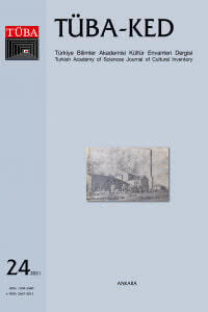LIVING CONDITIONS IN HOUSES OF ISTANBUL DURING THE 17TH CENTURY: A READING OF KADI REGISTRIES
___
Istanbul Kadı Registers Sicil no. 3 (İKR-3)Istanbul Kadı Registers Sicil no. TSMA-213 (İKR-213)
Istanbul Kadı Registers Sicil no. TSMA-225 (İKR-225)
Istanbul Kadı Registers Sicil no. TSMA-246 (İKR-246)
Rumeli Kadı Registers Sicil no. 35 (RKR-35)
Rumeli Kadı Registers Sicil no. 80 (RKR-80)
Rumeli Kadı Registers Sicil no. 116 (RKR-116)
Rumeli Kadı Registers Sicil no. 139 (RKR-139)Bab Kadı Registers Sicil no. 3 (BKR-3)
Bab Kadı Registers Sicil no. 46 (BKR-46)
AKGÜN ÖZKAYA, H. G., 2015. 18. Yüzyılda İstanbul Evleri Mimarlık, Rant, Konfor, Mahremiyet, İstanbul Araştırmaları Enstitüsü Yayınları, İstanbul.
ARTAN, T., 1989.Architecture As a Theatre of Life: Profile of The Eighteenth Century Bosphorus, Unpublished Doctoral Thesis, Massachusetts Institute of Technology.
BARKAN, Ö. L. / AYVERDI, E. H., 1970. İstanbul Vakıfları Tahrîr Defteri 953 (1546) Târîhli, İstanbul Fetih Cemiyeti Yayınları, İstanbul.
FAROQHI, S., 1987. Men of Modest Substance House Owners and House Property in Seventeenth –century Ankara and Kayseri, Cambridge University of Press, Cambridge.
İstanbul Büyükşehir Belediyesi, 1998. İstanbul Külliyâtı V İstanbul Ahkâm Defterleri İstanbul Vakıf Tarihi 1 (1742-1764). Istanbul Büyükşehir Belediyesi Kültür İşleri Başkanlığı Yayınları, Istanbul.
HASOL, D. 1998. Ansiklopedik Mimarlık Sözlüğü, YEM Publications, İstanbul.
ÖZKAYA, H. G., 2018.“Osmanlı Evleri Üzerine Yeniden Düşünmek: 18. Yüzyıldan Dahiliyeli-Hariciyeli Beş İstanbul Evi Örneği”, METU Journal of Faculty of Architecture, 35, 1, pp. 243-262.
ÖZYALVAÇ, Ş. P., 2015. İstanbul Konut Mimarisinde Lüks ve Konfor (18. yüzyıl), Unpublished Doctoral Thesis, Yıldız Technical University Department of Architecture, History and Theory of Architecture Graduate Program, Istanbul.
TANYELI, U., 1996. “Klasik Dönem Osmanlı Metropolünde Konutun ‘Reel’ Tarihi: Bir Standart Saptama Denemesi”, Prof. Dr. Doğan Kuban’a Armağan, Eren Yayıncılık, İstanbul, p.57–71.
TANYELI, U., 2003. “Norms of Domestic Comfort and Luxury in Ottoman Metropolises Sixteenth to Eighteenth Centuries”, The Illuminated Table, The Prosperous House,ed. Suraiya Faroqhi, Christoph K. Neumann, Ergon-Verl. Würzburg, p.301-16.
Türk Dil Kurumu, 1988.Türkçe Sözlük. Türk Dil Kurumu Yayınları, Ankara.
YERASIMOS, S., 2003. “Dwellings in sixteenth-century Istanbul”, The Illuminated Table, The Prosperous House,ed. Suraiya Faroqhi, Christoph K. Neumann, Ergon-Verl., Würzburg, p.275-300.
YÜKSEL, İ. A., 2005. Risale-i Mi’mariyye, Ca’fer Efendi, 1023/1614, İstanbul Fetih Cemiyeti Yayınları, İstanbul.
- ISSN: 1304-2440
- Yayın Aralığı: 2
- Başlangıç: 2003
- Yayıncı: Türkiye Bilimler Akademisi
SMYRNA/İZMİR KIRSALINDA YER ALAN BAZI SAVUNMA YAPILARI ÜZERİNE BİR DEĞERLENDİRME
Hakan GÖNCÜ, Burak YOLAÇAN, Akın ERSOY
İSLAM DÜNYASINDA BİYOGRAFİ YAZIMI VE RESİMLENMESİ
BABAESKİ SEMİZ ALİ PAŞA KÜLLİYESİ
Ayşe Gülçin KÜÇÜKKAYA, Tülay CANITEZ
LIVING CONDITIONS IN HOUSES OF ISTANBUL DURING THE 17TH CENTURY: A READING OF KADI REGISTRIES
KÜLTÜREL KAYNAK OLARAK KAMUSAL MEKÂN
İZMİR SARIKIŞLA’NIN İNŞA EVRELERİ
H. İbrahim ALPASLAN, E. Aysu GÜLENÇ
TARİHİ BİR SU YOLU AKSI: URFA HALİLÜRRAHMAN SU YOLU GÜZERGAHININ MİMARİ DOKUSU VE KORUMA SORUNLARI
Hatice Kübra İLHAN, Tülay ÇOBANCAOĞLU
ERKEN CUMHURİYET DÖNEMİNDE KAMUSAL MEKÂNDA MODERNLİĞİN TEMSİLİ: ISPARTA KENTİ ÖRNEĞİ
GEÇMİŞTEN GÜNÜMÜZE GAZOMETRE YAPILARI VE DOLMABAHÇE GAZOMETRESİ İÇİN OLASI İŞLEVLENDİRME ÖNERİLERİ
Halet Almıla ARDA BÜYÜKTAŞKIN, Elif TÜRKEL
